| |

Points & Native American
Relics - Page Two
|
Big Creek
Later Archaic to early Woodland
period, 3500 - 2500 B.P.
Origin: Arkansas
Material: Crowley's Ridge Cobble
Measurements: L 2-1/6" x W 1-5/16" A small to
medium size, short, broad, corner notched point with a bulbous base.
Believed to be related to Marcos points. -
Overstreet 10 p. 531
 Baker COA -
Grade: 8 |
 |
|
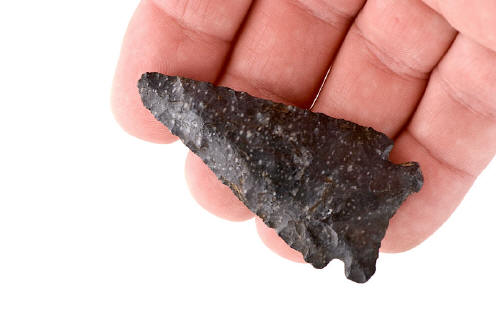
|
Big Sandy
Early to late Archaic, 10,000 - 3,000 B.P.
L 2.47" W 1.26"
Greater Big Sandy point
Description: The
red tint you see in photo #1 is heavy patina covered in dirt! Reverse has
much less covering (side down for +9 millennium). Elongated triangular shape
with a concave base. Maximum length is 6.35 cm (2 5/8"), max width is at
ears 3.24 cm (1 1/4"), max thickness 0.7 cm (1/4"). Cross-section is plano-convex.
Blade edges--looking directly at tip--is s-curvate. Blades very sharp. Tip
shows use but is sharp. One of the earliest types of the side notched
points. Found in northern extreme of normal sites, commonly found south of
the Ohio river valley, all the way down the Mississippi.
Most artifacts from the
Secrist collection show inscribed farm survey locations: S(outh)1/2
E(ast)1/2 N(orth)E(east) 1/4 S(ection)10 Twp (Township)2 SR12E (South of
Range 12 East) WytCo O (Wyandot County Ohio). Date Found:
between 1861-1930. There were 4 farms: 1) SE1/4.... 2) S1/2....
3) W1/2.... 4) NE1/4.... . W 1/2 is far-and-away the rarest! The first
of the 2,000+ points in the Secrist/Secrist collection sold were in 2001,
NONE BEFORE. Secrist gave-traded a few away in the 1910's. Seller unwrapped
the forgotten points in 1998 on basement shelves after the death of the 4th
generation. Now passed thru 5 generations of the Secrist family, stored in
1951 newspaper (Upper Sandusky) and cardboard boxes, full of dirt and sand.
Material:
High grade of Upper Mercer Coshocton Black Flint. Black with grey mottling.
Age: Early Archaic
period 8,000-6,000 BCE.
Found:
Wm Secrist Wyandot Co Wharton Ohio. Farm # 1. Marked in a blue/black
India ink: SE 1/4 1899-1-14
Grade: 9. No damage, prefect in size
and workmanship. OHS in Columbus archive scan Feb 2001" # 12.
Overstreet 10 p.350
- A small to medium size, side notched
point with early forms showing heavy basal grinding, serrations and
horizontal flaking. This type may be associated with the Frazier point,
being an un-notched form. Some examples have been carbon dated to 10,000
B.P., but most are associated with mid archaic times. |
|
Blade/Scraper Hybrid
With special usage on the
smooth area
L
2.67" W 1.77"
The point is from five miles outside of
Elyria, Ohio. Elyria is in Lorain County, in Northern Ohio, west of
Cleveland. The collection was picked up in the 1930’s and 1940’s from
behind a horse-drawn plow by a farmer as he was plowing the fields of his
100 acre farm.
The
flint type is Upper Mercer (also known as Coshocton- from Coshocton
County, Ohio, where there are a number of outcroppings of the material).
It is probably the most common flint type in Ohio.
|
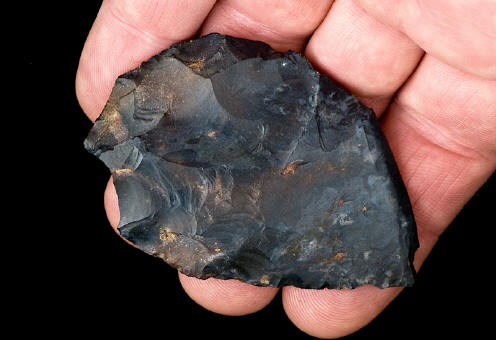 |
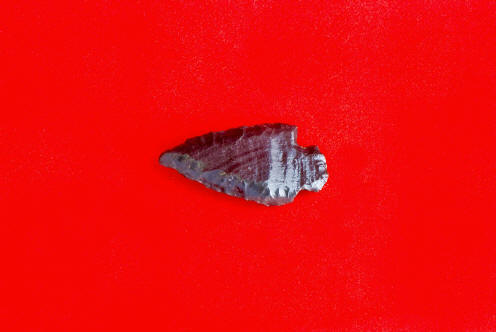 |
Borax Lake ?
Early Archaic, 8000 - 5000 B.P.
L 1.21" W .61"
Material: Obsidian
Provenance: Found as a surface find by Catherine Horne
of Descanso. Off highway 395 north of Mono Lake.
Note: This corner notched head
has a small piece from one of the barbs missing
Grinding base reduction?
Beveled
N. California into S.
Oregon and occasionally into W. Nevada. This type has an elongated,
triangular blade when pristine with a wide, approximately square stem. Stem
sides are often ground. Bases are straight to slightly convex. - Overstreet 10 p. 975
|
|
Buck Taylor
Classical to Historic Phase, 600 - 200 B.P.
L 3/4" W 1/2"
A small triangular, tri
notched arrow point including a deep basil notch. Part of the Pueblo
Side Notched cluster. - Overstreet 10 p.
824
Reportedly found in Arizona
|
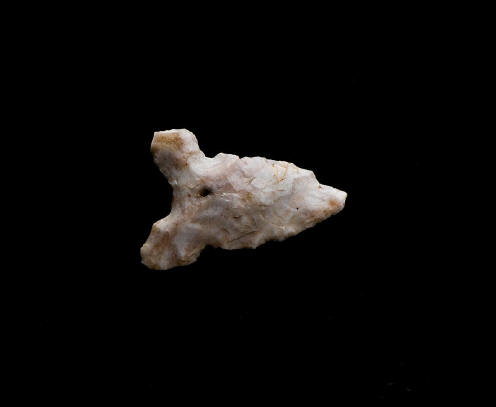 |
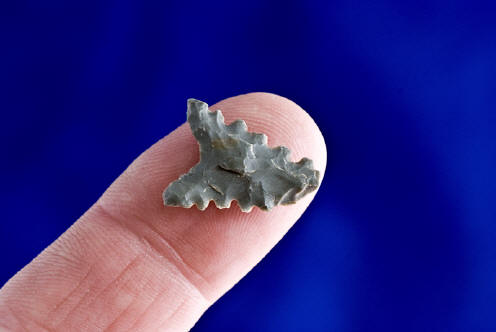
Point Type:
Canaliño
Triangular Arrow Point
Length: 3/4 inch
Age: 200 to 800 years old
Material: Felsite
Provenance: Found as a surface find during the summer of 2008 on private
land north of Descanso, California by Rob Horne of Descanso.
Note: The tip of this point is missing. In its original, undamaged state, it
was probably 35 to 40% longer than seen above, placing it at over one inch
in length when made by the aboriginal.
Collection of: Rob Horne
Information and photo on right provided by
Steve Stangland
of AACA |
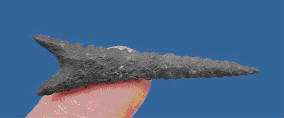
Although probably not as elongated as this
arrowpoint, the point seen on the left, in its original form, would
have looked similar to this complete Canalino point. 
Kumeyaay Indians - Our valley was the
site of their seasonal campsites during the hot summer months as they would
travel from the eastern desert to collect acorns and avoid raiding parties
from the Yuma area Indians.
Most sources say that the Kumeyaay territory extended south to Baja
California and east to the Imperial Valley. |
|
Point Type:
Canaliño Arrow Point
L .93"
W .40"
Age: 200 to 800 years old
Material: Felsite, chert
Provenance: Found as a surface find 1999 on private
land north of Descanso, California by Rob Horne
of Descanso. A
small size, thin, triangular arrow point with a shallow to deep concave
base. Some are serrated. Also known as Coastal Cottonwood. - Overstreet 10 p. 978 |
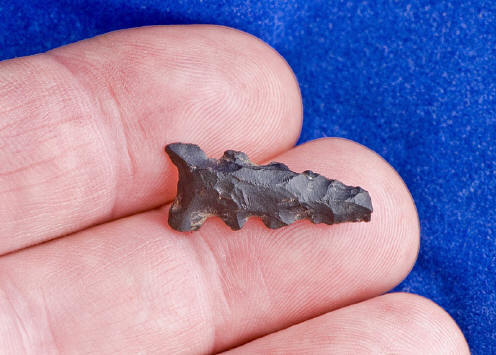 |
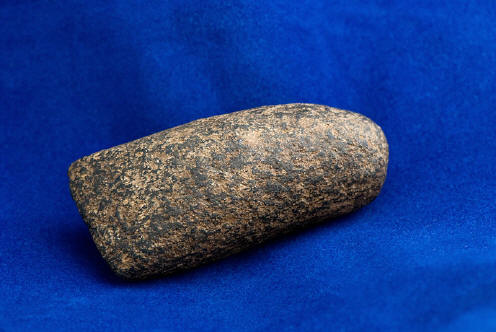 |
Celt - Axe Bit
Celts are associated with the Woodland times
through the Mississippian.
L 2.84" W 1.35"
Missouri
Un-grooved axe used for
small chopping jobs. The round end was tightly inserted into a hole chiseled
into a wood or bone handle. Probably held into place with adhesive and tied
as well.
Made of hardstone (the
generic term used when the collector doesn't know the material).
Shows both polished and
pecked surface. Pecking was done to shape stone tools with the use of a
hammerstone. The craftsman would strike the target rock to shape its surface
by removing little pecks of material. Then, with the use of sand, sandstone
or some other abrasive material, the surface would be ground or sanded to
the desired smoothness*
* Ancient Indian
Artifacts - Volume 1 - Jim Bennett
|
|
Celt - Axe
3" long, 1 3/8" wide, found
in Clay County, Missouri |
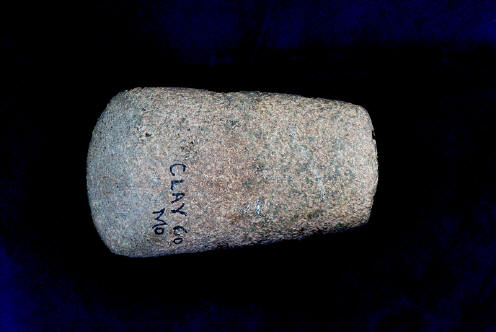 |
|
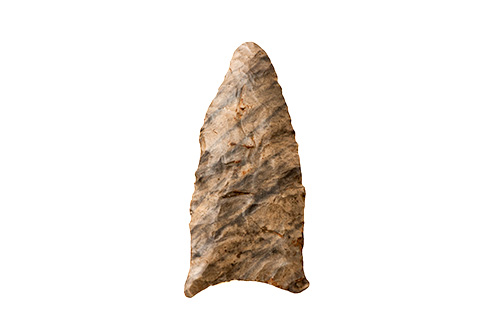
|
Clovis - Unfluted
Paleo, 11,50 - 10,600 B.P.
L 2-1/4" W 15/16"
Fort Pain Chert
Kentucky
Ex-Will Burchett collection
A medium to large size, auriculate point
identical to the fluted Clovis. A very rare type as most Clovis points are
fluted in their finished form. The flaking can be random to parallel. Clovis
is the earliest point type in the hemisphere. Clovis technology more closely
matches European Solutrean forms than anywhere else. There is no pre-Clovis
evidence here. The first Clovis find associated with Mastodons was in 1979
at Mastodon State Park, Jefferson Co., MO. in the Kimmswick bone bed dated
to 12,000 B.P. carbon years.
Overstreet 10 p. 366

Baker COA |
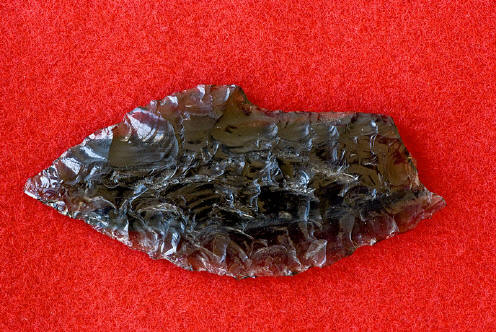 |
Clovis Reproduction
2.5 " Created by Chris Hardaker for Catherine Horne Christopher Hardaker
earned an M.A. in anthropology from the University of Arizona and entered
the profession as a field archaeologist 30 years ago.
BIPOLAR REDUCTION: Variability or Chaos
Christopher Hardaker, Tucson, AZ
|
|
Soon |
Culpepper Bifurcate
Granville County, North
Carolina. |

| |
|
Useful
Resources
|
|
|

Authentic
Artifact
Collectors
Association
______
Overstreetid.com
The Official Overstreet Indian
Arrowhead Identification Online Database
______
|
|
|
|
|
|
|